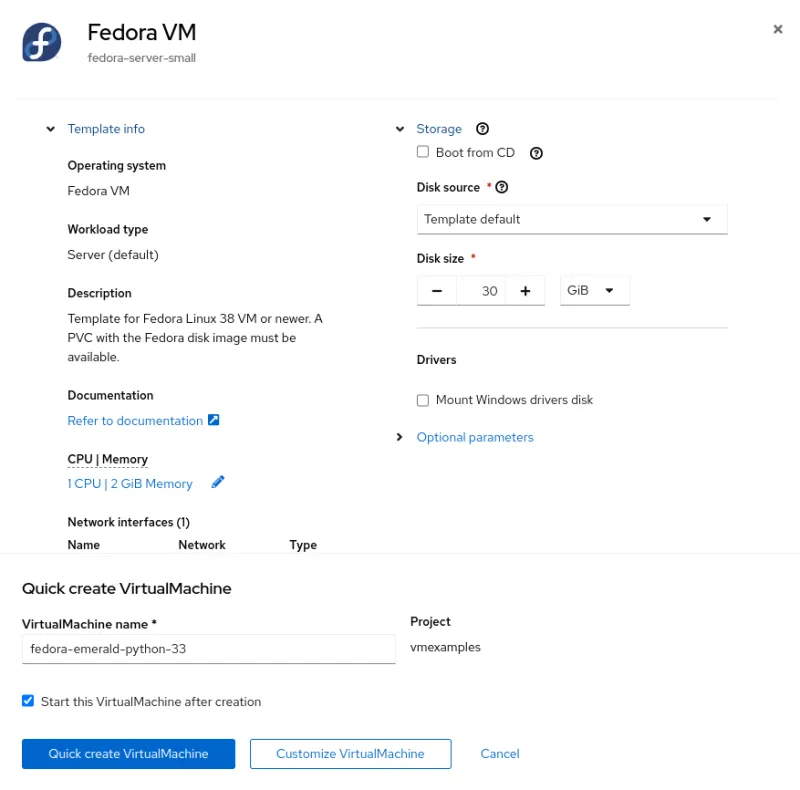Angesichts der neuesten Nachrichten auf dem Virtualisierungsmarkt besteht eine gute Chance, dass Sie nach einer Alternative für Ihre aktuellen VM-Workloads suchen. Die gute Nachricht ist, dass Red Hat eine passende Lösung für Sie anbietet. Red Hat OpenShift Virtualization, eine Funktion in Red Hat OpenShift, bietet eine moderne Plattform, mit der Sie neue und vorhandene VM-Workloads ausführen und bereitstellen können. Sie können traditionelle VMs als Teil Ihrer einheitlichen Hybrid Cloud-Plattform migrieren und managen.
Wenn es Ihnen wie mir geht, wollen Sie ein Produkt, bevor Sie es kaufen, wahrscheinlich zuerst ausprobieren. Die OpenShift Virtualization Roadshow bietet Ihnen die Möglichkeit, genau das in einer Lab-Umgebung zu tun und Fragen an unsere Experten für OpenShift Virtualization zu stellen.
Was wird im Red Hat OpenShift Virtualization Lab behandelt?
Bekannte Umgebung: Dieser Teil des Labs gibt Ihnen einen Überblick über die unterstützten Plattformen für OpenShift Virtualization. Außerdem können Sie sich mit den Anforderungen für die Ausführung des Operators vertraut machen und eine Einführung in die Benutzeroberfläche erhalten, die zum Verwalten Ihrer virtuellen Maschine verwendet wird.

Die obige Abbildung zeigt, was die OpenShift Virtualization-Administration auf der Übersichtsseite sehen würde.
Virtual Machine Management: In diesem Abschnitt erhalten Sie einen Überblick über die Grundlagen von OpenShift Virtualization, einschließlich der Erstellung einer VM, der Änderung der zugeteilten Ressourcen, der Verwaltung des Status und der Durchführung einer Live-Migration zwischen Hypervisor-Knoten.

In der obigen Abbildung werden der Assistent zum Erstellen virtueller Rechner aus den bereitgestellten Vorlagen und die Optionen angezeigt, die angepasst werden können.
Bare Metal-Infrastrukturmanagement: Bei zunehmenden Workloads ist es unerlässlich, dass die physischen Ressourcen eines Clusters dynamisch und automatisiert skaliert werden können. Wir prüfen, wie wir unserem Cluster bei Bedarf weitere Knoten hinzufügen können, indem wir unser Deployment mit Metal3 vertikal skalieren, um zusätzliche Bare-Metal-Knoten zu ermitteln und zu verwalten.

Die obige Abbildung zeigt den Prozess der Provisionierung eines zusätzlichen Bare Metal-Knotens für den Fall, dass Ihr Cluster skaliert werden muss.
Storage-Management: Red Hat OpenShift unterstützt mehrere Arten von Storage, ob On-Premise oder in der Cloud. OpenShift Virtualization kann viele unterstützte Container Storage Interface (CSI)-Provisioner in Ihrer Umgebung verwenden.In diesem Modul werden Sie durch die grundlegenden Storage-Konzepte in OpenShift geführt und erfahren, wie Sie andere Aufgaben im Zusammenhang mit dem Disk-Storage der VM ausführen, z. B. das Erstellen und Wiederherstellen eines Snapshots und das Klonen einer VM.

Die obige Abbildung zeigt den Prozess beim Klonen einer VM.
Netzwerkverwaltung: VMs können an das Software-Defined Network von OpenShift angehängt werden, das den Zugriff von anderen Workloads auf dem OpenShift-Cluster ermöglicht, einschließlich anderer VMs und OpenShift-nativer Anwendungen. VMs können jedoch bei Bedarf auch eine direkte Verbindung zu einem oder mehreren externen Netzwerken, z. B. VLANs, herstellen. In diesem Modul lernen Sie, wie Sie eine Network Attachment Definition erstellen und eine VM mit dem externen Netzwerk verbinden. Außerdem erfahren Sie, wie Sie den Datenverkehr filtern und den Zugriff auf Ihre VMs durch Implementierung mehrerer Netzwerkrichtlinien sichern.
Vorlagenverwaltung: Zur Optimierung der Bereitstellung von VMs erstellen Administratoren häufig Vorlagen, um das Deployment zu vereinfachen. Wir konzentrieren uns darauf, bestehende Linux-Vorlagen im OpenShift Virtualization Katalog zu klonen und sie für bestimmte Workloads anzupassen. Außerdem werden wir eine neue Microsoft Windows-Vorlage über Installationsmedien erstellen und sie für zukünftige Deployments wiederverwendbar machen.

Der integrierte Vorlagenkatalog ermöglicht ein schnelles Deployment virtueller Rechner.
Migration Toolkit for Virtualization: Das Migration Toolkit for Virtualization (MTV) ist eine in OpenShift enthaltene Funktion, die den Migrationsprozess von anderen Hypervisoren zu OpenShift Virtualization vereinfacht. In diesem Teil der praktischen Übung wird gezeigt, wie Sie das MTV verwenden, um eine VM aus Ihrer aktuellen Umgebung in OpenShift Virtualization zu importieren. Eine Demo zum Importieren vorhandener virtueller Maschinen in OpenShift Virtualization mit MTV können Sie sich hier ansehen.

Eine virtuelle Anwendung, die mit dem Migration Toolkit for Virtualization zu OpenShift Virtualization migriert wurde.
Wie können Sie an einem Workshop teilnehmen?
Beim Red Hat Summit 2024 in Denver, Colorado, letzte Woche waren Sie vielleicht eine der über 200 Personen, die eine komprimierte Version des Workshops absolvieren konnten. Wenn Sie an einem anderen Workshop teilnehmen möchten, um zusätzliche Themen zu vertiefen oder anderen einen Workshop vorzuschlagen, klicken Sie auf den unten stehenden Link, um sich anzumelden.
Unabhängig davon, ob Sie am Red Hat Summit teilgenommen haben oder nicht, die OpenShift Virtualization Roadshow kommt in eine Stadt in Ihrer Nähe! Die Roadshow beinhaltet das Lab, das wir gerade betrachtet haben, sowie einen Überblick über das Produktangebot und die Vorteile, die es zu bieten hat.
Wenn Sie OpenShift Virtualization noch nicht kennen, lesen Sie unser E-Book: 15 Gründe, warum Sie OpenShift Virtualization einführen sollten. Darin erfahren Sie, wie Sahibinden OpenShift Virtualization für die Modernisierung seiner Infrastruktur nutzen konnte.
Erhalten Sie einen umfassenden Überblick über das Produkt, und sehen Sie sich Videos an, um Red Hat OpenShift Virtualization besser kennenzulernen.
Red Hat unterstützt Sie bei der Migration und Modernisierung Ihrer vorhandenen VM-Infrastruktur. Mit Red Hat OpenShift Virtualization kann Ihr Unternehmen VM-basierte Anwendungen mit einer einheitlichen Ansicht und konsistenten Tools modernisieren, um VMs, Container und Serverless-Komponenten konsistent On-Premise, in der AWS Public Cloud und am Edge zu verwalten. Wir freuen uns darauf, Sie bei einer Roadshow in Ihrer Nähe zu sehen.
Über die Autoren
Courtney started at Red Hat in 2021 on the OpenShift team. With degrees in Marketing and Economics and certificates through AWS and Microsoft she is passionate about cloud computing and product marketing.
Nach Thema durchsuchen
Automatisierung
Das Neueste zum Thema IT-Automatisierung für Technologien, Teams und Umgebungen
Künstliche Intelligenz
Erfahren Sie das Neueste von den Plattformen, die es Kunden ermöglichen, KI-Workloads beliebig auszuführen
Open Hybrid Cloud
Erfahren Sie, wie wir eine flexiblere Zukunft mit Hybrid Clouds schaffen.
Sicherheit
Erfahren Sie, wie wir Risiken in verschiedenen Umgebungen und Technologien reduzieren
Edge Computing
Erfahren Sie das Neueste von den Plattformen, die die Operations am Edge vereinfachen
Infrastruktur
Erfahren Sie das Neueste von der weltweit führenden Linux-Plattform für Unternehmen
Anwendungen
Entdecken Sie unsere Lösungen für komplexe Herausforderungen bei Anwendungen
Virtualisierung
Erfahren Sie das Neueste über die Virtualisierung von Workloads in Cloud- oder On-Premise-Umgebungen

